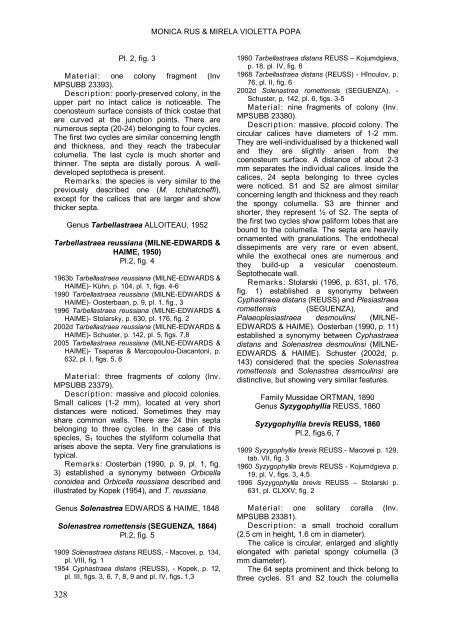taxonomic notes on the badenian corals from lăpugiu de sus
taxonomic notes on the badenian corals from lăpugiu de sus
taxonomic notes on the badenian corals from lăpugiu de sus
You also want an ePaper? Increase the reach of your titles
YUMPU automatically turns print PDFs into web optimized ePapers that Google loves.
MONICA RUS & MIRELA VIOLETTA POPA<br />
Pl. 2, fig. 3<br />
Material: <strong>on</strong>e col<strong>on</strong>y fragment (Inv<br />
MPSUBB 23393).<br />
Descripti<strong>on</strong>: poorly-preserved col<strong>on</strong>y, in <strong>the</strong><br />
upper part no intact calice is noticeable. The<br />
coenosteum surface c<strong>on</strong>sists of thick costae that<br />
are curved at <strong>the</strong> juncti<strong>on</strong> points. There are<br />
numerous septa (20-24) bel<strong>on</strong>ging to four cycles.<br />
The first two cycles are similar c<strong>on</strong>cerning length<br />
and thickness, and <strong>the</strong>y reach <strong>the</strong> trabecular<br />
columella. The last cycle is much shorter and<br />
thinner. The septa are distally porous. A well<strong>de</strong>veloped<br />
septo<strong>the</strong>ca is present.<br />
Remarks: <strong>the</strong> species is very similar to <strong>the</strong><br />
previously <strong>de</strong>scribed <strong>on</strong>e (M. tchihatcheffi),<br />
except for <strong>the</strong> calices that are larger and show<br />
thicker septa.<br />
Genus Tarbellastraea ALLOITEAU, 1952<br />
Tarbellastraea reussiana (MILNE-EDWARDS &<br />
HAIME, 1950)<br />
Pl.2, fig. 4<br />
1963b Tarbellastraea reussiana (MILNE-EDWARDS &<br />
HAIME)- Kühn, p. 104, pl. 1, figs. 4-6<br />
1990 Tarbellastraea reussiana (MILNE-EDWARDS &<br />
HAIME)- Oosterbaan, p. 9, pl. 1, fig., 3<br />
1996 Tarbellastraea reussiana (MILNE-EDWARDS &<br />
HAIME)- Stolarsky, p. 630, pl. 176, fig. 2<br />
2002d Tarbellastraea reussiana (MILNE-EDWARDS &<br />
HAIME)- Schuster, p. 142, pl. 5, figs. 7,8<br />
2005 Tarbellastraea reussiana (MILNE-EDWARDS &<br />
HAIME)- Tsaparas & Marcopoulou-Diacant<strong>on</strong>i, p.<br />
632, pl. I, figs. 5, 6<br />
Material: three fragments of col<strong>on</strong>y (Inv.<br />
MPSUBB 23379).<br />
Descripti<strong>on</strong>: massive and plocoid col<strong>on</strong>ies.<br />
Small calices (1-2 mm), located at very short<br />
distances were noticed. Sometimes <strong>the</strong>y may<br />
share comm<strong>on</strong> walls. There are 24 thin septa<br />
bel<strong>on</strong>ging to three cycles. In <strong>the</strong> case of this<br />
species, S 1 touches <strong>the</strong> styliform columella that<br />
arises above <strong>the</strong> septa. Very fine granulati<strong>on</strong>s is<br />
typical.<br />
Remarks: Oosterban (1990, p. 9, pl. 1, fig.<br />
3) established a syn<strong>on</strong>ymy between Orbicella<br />
c<strong>on</strong>oi<strong>de</strong>a and Orbicella reussiana <strong>de</strong>scribed and<br />
illustrated by Kopek (1954), and T. reussiana.<br />
Genus Solenastrea EDWARDS & HAIME, 1848<br />
Solenastrea romettensis (SEGUENZA, 1864)<br />
Pl.2, fig. 5<br />
1909 Solenastraea distans REUSS, - Macovei, p. 134,<br />
pl. VIII, fig. 1<br />
1954 Cyphastraea distans (REUSS), - Kopek, p. 12,<br />
pl. III, figs. 3, 6, 7, 8, 9 and pl. IV, figs. 1,3<br />
1960 Tarbellastraea distans REUSS – Kojumdgieva,<br />
p. 18. pl. IV, fig. 6<br />
1968 Tarbellastraea distans (REUSS) - Hînculov, p.<br />
76, pl. II, fig. 6<br />
2002d Solenastrea romettensis (SEGUENZA), -<br />
Schuster, p. 142, pl. 6, figs. 3-5<br />
Material: nine fragments of col<strong>on</strong>y (Inv.<br />
MPSUBB 23380).<br />
Descripti<strong>on</strong>: massive, plocoid col<strong>on</strong>y. The<br />
circular calices have diameters of 1-2 mm.<br />
They are well-individualised by a thickened wall<br />
and <strong>the</strong>y are slightly arisen <strong>from</strong> <strong>the</strong><br />
coenosteum surface. A distance of about 2-3<br />
mm separates <strong>the</strong> individual calices. Insi<strong>de</strong> <strong>the</strong><br />
calices, 24 septa bel<strong>on</strong>ging to three cycles<br />
were noticed. S1 and S2 are almost similar<br />
c<strong>on</strong>cerning length and thickness and <strong>the</strong>y reach<br />
<strong>the</strong> sp<strong>on</strong>gy columella. S3 are thinner and<br />
shorter, <strong>the</strong>y represent ½ of S2. The septa of<br />
<strong>the</strong> first two cycles show paliform lobes that are<br />
bound to <strong>the</strong> columella. The septa are heavily<br />
ornamented with granulati<strong>on</strong>s. The endo<strong>the</strong>cal<br />
dissepiments are very rare or even absent,<br />
while <strong>the</strong> exo<strong>the</strong>cal <strong>on</strong>es are numerous and<br />
<strong>the</strong>y build-up a vesicular coenosteum.<br />
Septo<strong>the</strong>cate wall.<br />
Remarks: Stolarski (1996, p. 631, pl. 176,<br />
fig. 1) established a syn<strong>on</strong>ymy between<br />
Cyphastraea distans (REUSS) and Plesiastraea<br />
romettensis (SEGUENZA), and<br />
Palaeoplesiastraea <strong>de</strong>smoulinsi (MILNE-<br />
EDWARDS & HAIME). Oosterban (1990, p. 11)<br />
established a syn<strong>on</strong>ymy between Cyphastraea<br />
distans and Solenastrea <strong>de</strong>smoulinsi (MILNE-<br />
EDWARDS & HAIME). Schuster (2002d, p.<br />
143) c<strong>on</strong>si<strong>de</strong>red that <strong>the</strong> species Solenastrea<br />
romettensis and Solenastrea <strong>de</strong>smoulinsi are<br />
distinctive, but showing very similar features.<br />
Family Mussidae ORTMAN, 1890<br />
Genus Syzygophyllia REUSS, 1860<br />
Syzygophyllia brevis REUSS, 1860<br />
Pl.2, figs.6, 7<br />
1909 Syzygophyllia brevis REUSS.- Macovei p. 129,<br />
tab. VII, fig. 3<br />
1960 Syzygophyllia brevis REUSS - Kojumdgieva p.<br />
19, pl. V, figs. 3, 4,5<br />
1996 Syzygophyllia brevis REUSS – Stolarski p.<br />
631, pl. CLXXV; fig. 2<br />
Material: <strong>on</strong>e solitary coralla (Inv.<br />
MPSUBB 23381).<br />
Descripti<strong>on</strong>: a small trochoid corallum<br />
(2.5 cm in height, 1.6 cm in diameter).<br />
The calice is circular, enlarged and slightly<br />
el<strong>on</strong>gated with parietal sp<strong>on</strong>gy columella (3<br />
mm diameter).<br />
The 64 septa prominent and thick bel<strong>on</strong>g to<br />
three cycles. S1 and S2 touch <strong>the</strong> columella<br />
328

















